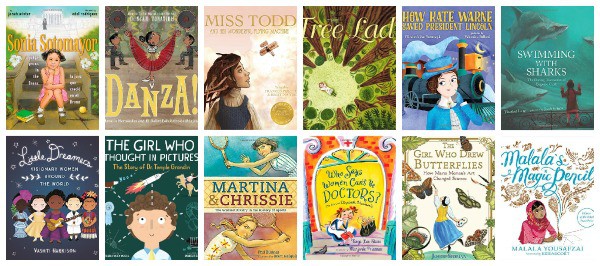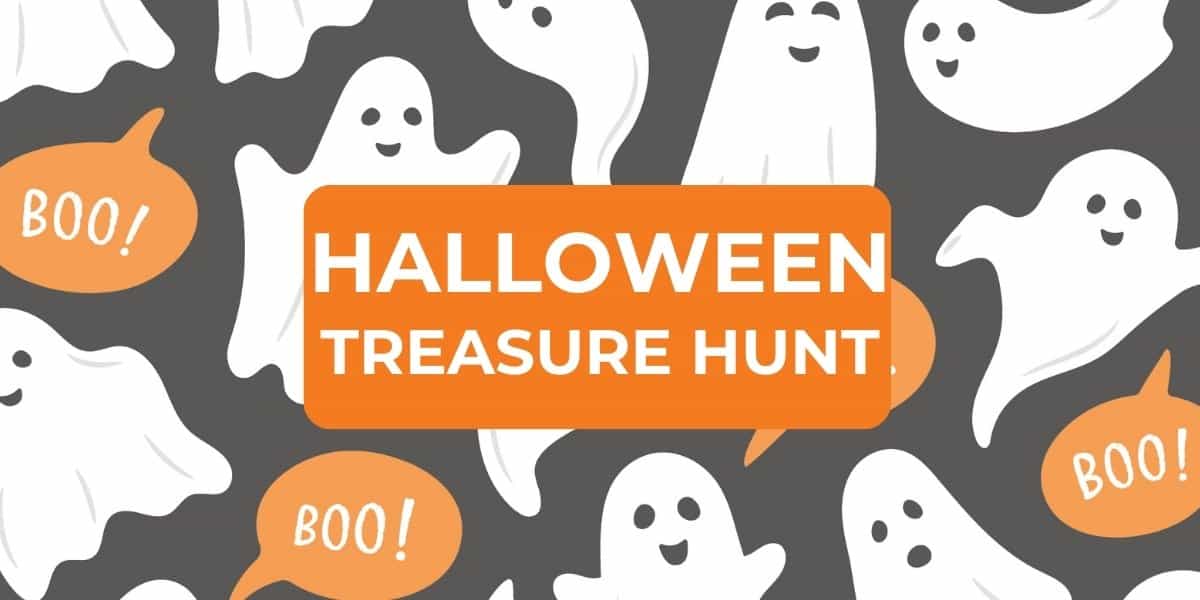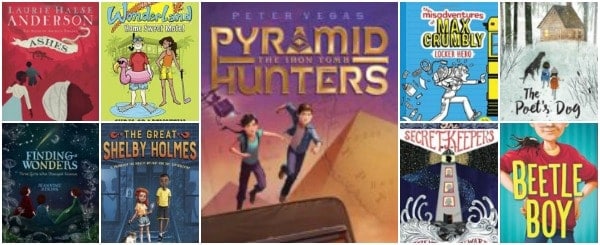Impressive Nonfiction Books for 3rd Graders (8 Year Olds)
This post may contain affiliate links.
Get your 8-year-olds reading nonfiction books for 3rd graders! It’s SO important to have a balance of fiction and nonfiction in their reading diet. Why? Because it’s extremely important for readers’ future success when they’ll be required to read for information in the upper grades, middle school, and high school.
Since reading nonfiction is a different kind of reading comprehension, be sure that you’re teaching kids about text features, text structures, and reading strategies like determining importance, questioning, synthesizing, and connecting to background knowledge.
Practice reading nonfiction with good books from this list of my favorite nonfiction books for 8 year olds, plus a few informational fiction books

ALSO READ:
Nonfiction Reading Comprehension Strategies
Nonfiction Books for 3rd Graders, 8 Year Olds

Animals in Pants by Suzy Levinson, illustrated by Kristen & Kevin Howdeshell
These funny poems will delight readers with their rhyming and silliness. Manatees in dungarees, kangaroos in jumpsuits, giraffes in kilts, and spiders who put on their pants one leg, one leg, one leg, times eight at a time.
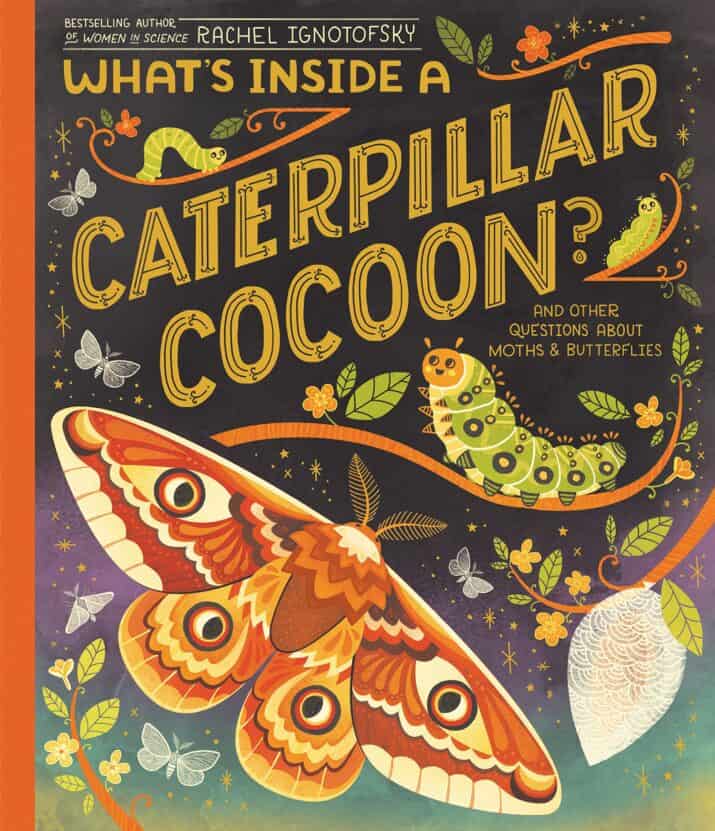
What’s Inside a Caterpillar Cocoon? and Other Questions About Moths & Butterflies by Rachel Ignotofsky
Just wait until you see the gorgeous illustrations throughout this book. I could frame them all! Learn all about moths and butterflies, starting with their differences, their life stages, their metamorphosis, their anatomy, and more interesting information about their diet, mating, and spreading pollen. Kids will love reading about these important insects. Perfect for primary-grade classrooms and homes.

Erno Rubik and His Magic Cube written by Kerry Aradhya, illustrated by Kara Kramer
This biography works well and will appeal to children! I love the author’s use of questions within the story, keeping readers engaged and showing Erno’s curiosity. I also REALLY loved the bold colors and visual layout of the illustrations and text. Bravo to a biography children will actually want to read!

Gross Factopia! Follow the Trail of 400 Foul Facts written by Paige Towler, illustrated by Andy Smith
Brightly colored, eye-catching designs of photos and cartoons grab your attention as do the fun facts. Kids will love everything about these gross facts and this whole series.

Search for a Giant Squid: Pick Your Path by Amy Seto Forrester & Andy Chou Musser
I love this choose your own adventure informational fiction book (nonfiction adjacent) and so will kids. Join an expedition on a dive to the deepest ocean depths to search for a giant squid. Choose which pilot to be, the submersible you’ll use, and the dive site, and then start your adventure. What will you discover? What will you do with mechanical problems or bad weather?

The Squirrels’ Busy Year (A First Science Storybook) by Martin Jenkins, illustrated by Richard Jones
Follow the owl and squirrels as they go through a year. The book starts with winter, when the squirrels are “curled up in their cozy nest.” Each season shows readers the different weather and behavior of the animals. It’s a lovely introduction to seasons and animals.

Mars: Earthlings Welcome by Stacy McAnulty, illustrated by Stevie Lewis
Mars is a planet with a big personality. In first-person narration, Mars shares all its many features that are much better than Earth. Like two moons and 37 more minutes in a day! It’s funny, entertaining, and very informative. I would love to use this in a writing class to teach voice, point of view, and even organization.

Except Antarctica! by Todd Sturgell (informational fiction)
A stoic narrator shares information about turtles until…the turtle, who isn’t a creature from Antarctica, travels to Antarctica, making the narrator very irked. Soon, the turtle is joined by other animals also NOT found in Antarctica. Hilarity ensues with an increasingly exasperated narrator and bothered turtle who does not want any traveling companions which include a dung beetle, owl, snake, bee, mouse, and frog.

Ode to a Grapefruit: How James Earl Jones Found His Voice written by Kari Lavelle, illustrated by Bryan Collier
THIS IS HOW YOU WRITE A BIOGRAPHY! The author captures the right scenes of James Earl’s life to show his fear of speaking because of a stutter, his introduction to poetry that led him to begin writing his own poems and speaking them out loud. Why do I love this book so much? Because it’s not a boring birth to death, too-much-text tome. It’s perfect in every way. Plus, Bryan Collier’s illustrations are rich and evocative, adding everything to the ambiance of this beautiful biography.

Almanac 2025 National Geographic Kids
The National Geographic Almanac is a must-own resource for families. Build your knowledge and practice your nonfiction reading comprehension skills while you learn about animals, space, science, history, geography, and much more. Each page is designed to entertain and educate with stunning layouts and eye-popping photographs. Keep your kids reading with this densely packed, exciting book!

Survival Scout Tsunami written and illustrated by Maxwell Eaton III
Who wants to get their 9 to 12-year-old readers reading more nonfiction? This hybrid (fiction/nonfiction) visually appealing graphic novel series could be your best gateway book to introduce readers to nonfiction in an appealing way. This story is about a girl and her skunk who experience an earthquake. The girl’s dialogue plus nonfiction informational sections explain the science of what’s happening. Alongside the skunk, readers will learn about plate tectonics, tsunamis, landslides, and much more about the science and preparedness related to earthquakes and tsunamis. I liked the balance of narrative and expository text, especially for readers who prefer one or the other so they can get practice reading both. Plus, I loved the illustrations —super engaging— and appreciated the larger size typeface.

Who Would Win? Whale vs. Giant Squid by Jerry Pallotta, illustrated by Rob Bolster
Teachers tell me that their students can’t get enough of the Who Would Win? books. This book pits two ocean carnivores against each other. First, you’ll learn facts about a sperm whale, then you’ll learn about the giant squid. Finally, read what happens when these two creatures face-off. Can you predict who will win? See all the addicting informational books in the Who Would Win series.

Magical Museum Ancient Egypt written by Stepanka Sekaninova, illustrated by Jakub Cenkl
This Egypt book has oversized pages with colorful illustrations and readable text with bolded words. Kids will love that different characters from King Tut, a mummy cat, and a mouse relay information in dialogue bubbles. Fun!

My Antarctica written by G. Neri, illustrated by Corban Wilkin
Written like a diary and laid out like one with photos and cartoon drawings of the author on every spread, this is the first-person account of traveling to the coldest place on earth simply because of his curiosity. The author followed the science teams and went everywhere to learn as much as he could about Antarctica. It’s a mesmerizing book that is voice-y and also packed full of information about science, creatures, jobs, penguin encounters, famous explorers, gear, and much more.

Mouse Town 30+ Kids Crafts Made From Recycled and Everyday Materials written by Jodi Levine & Margaret McCartney
If your kids are like my youngest and like tiny things and upcycling, they will love this darling book about making a mouse town. It’s a fabulous combination of story and craft projects about two mice friends! Build your own mouse town with a mouse house out of a milk crate and accessories like a bed, a dresser, and toys. Read how to build buildings for the town, like a bakery and library, and add lots of itty bitty things like fruit and toy food. All the craft projects list the materials needed and are well written, making them easy to follow with photographic directions, plus adorable cardboard mice photos.

The Story of Olympic Swimmer Duke Kahanamoku by Ellie Crowe, illustrated by Richard Waldep
Well-written like all of the books in this series and totally fascinating! Kids will love learning about cool but lesser-known people like Duke, a famous Hawaiian who is known for his dominance of the sport of surfing as well as being an Olympic swimmer. Helpful informational insets give readers background on topics covered in the biography such as how surfboards are made. Love it.

Little Guides to Great Lives Anne Frank by Isabel Thomas, illustrated by Paola Escobar
Anne started a diary that would share how the world was changing with the rise of the Nazis in Europe. In her diary, Anne described her life in hiding which was in the building of her father’s business. She dreamed of becoming a writer after the war but never got the chance. This biography shares about the events surrounding Anne’s life with a call to action to read The Diary of Anne Frank for yourself. (When you’re older.) Lavender and red illustrations throughout support readers as they read the information.

Little Guides to Great Lives Nelson Mandela by Isabel Thomas, illustrated by Hannah Warren
This is another new 2018 biography series that I highly recommend for elementary-age readers. Written like a narrative story, these little books are fast-paced and informative. This particular title is about one of the world’s most admired activists and leaders, Nelson Mandela. Little Guides to Great Lives series contain perfect text to picture ratio, captivating illustrations, informative content, and just-right pacing. Plus, they’re very well-written.

Mini Architects 20 Projects Inspired by the Great Architects written by Josephine Seblon, illustrated by Robert Sae-Heng
If my kids were little, I would use this book not just for a homeschool unit but for home enrichment, too. The book introduces different 20 architectural examples from the past, modern, and contemporary, including Stonehenge, la Sagrada Familia, and Dandaji market. Each structure includes a photo or drawing and more about the structure as well as things to discuss. Then, follow the step-by-step directions to make your own craft project to resemble the architecture. I love the combination of illustrations and photos, as well as the clear writing. This is a fascinating two-in-one book: informational with hands-on crafts.

Animals on the Move(Animal Planet) by Dorothea DePrisco (ages 7+)
Get schooled with this fascinating book about animals. It focuses on the how and why these animals move as well as cool facts. For example, did you know the gnu moves in a zigzag pattern when in danger and kicks up a dust storm when it spars? Great for kids who love bite-sized facts about animals, or any nonfiction subject.

What If You Had an Animal Nose!? by Sandra Markle, illustrated by Howard McWilliam
The colorful, well-designed layout makes this pleasing to read. First, you’ll read a page with color photographs and information about the animal’s unique nose. Then, the next page shows an illustration with a kid that has the animal nose instead of a human nose. What noses will you learn about? An elephant, tapir, cottontail rabbit, saiga, star-nosed mole, rhinoceros, giant anteater, Bourret’s horseshoe bat, and hammerhead shark. The book concludes with information extolling the virtues of you human nose. Plus, how to take good care of it.

Wind by Olga Fadeeva, translated by Lena Traer
I adore the design of this book, including the font, the illustrations, and the stylizations. The author starts by wondering about the wind’s fictional sources and then explains wind science in kid-friendly language. You’ll read about measuring wind in knots, how wind helps plants and animals, wind in sailing, wind power, and much more.

The Inventors of LEGO Toys by Erin Hagar, illustration by Paige Garrison
This informational book rocks! It’s well-written, nicely illustrated, and very interesting! Learn the history of Ole Kirk Christiansen and his start as a woodworker. From yo-yos to plastic bricks to LEGO now, this is one of the best nonfiction books I’ve seen. Highly recommended.

I Wish I Had a Wookie and Other Poems for Our Galaxy by Ian Doescher, illustrated by Tim Budgen
So cute and fun, this playful book of poems will delight Star Wars fans with poems all about kids and their relationship to (and love for) Star Wars. I honestly adore these poems — and there are SO many to read. For example, “Counting Jawas” is a new take on the counting sheep bedtime ritual. “My Room’s the Millennium Falcon” shares how much the boy loves his room and imagines adventures there as if he’s flying in the Millennium Falcon.

Listen to the Language of Trees: A Story of How Forest Communicate Underground by Tera Kelley, illustrated by Marie Hermansson
In a busy forest of plants and animals, a squirrel grabs a pinecone and buries it. In that pinecone hung a seed that rests underground. The seed listens to the trees talk to each other through their roots. And a giant tree sends the little seed nourishment. Beautiful, descriptive writing with action verbs show the seedling waiting and watching as danger arrives and how the forest communicates.

A Day in the Life of an Astronaut, Mars, and the Distant Stars by Mike Barfield and Jess Bradley
SOLAR SYSTEM
Learn about the solar system in this nonfiction comic book. The day in the life stories are first-person personified stories from the point of view of things like a Death Cloud, Meteorite, and Nebula. Packed full of information, the other story formats include bigger picture sections and secret diaries. For example, you’ll like reading the secret diary of a space monkey. Honestly, it’s amazing how much information this book teaches readers about space and how appealing it is!

Professor Wooford McPaw’s History of Cars by Elliot Kruszynski
Cute cartoon illustrations (and just overall cuteness) introduce you to a dog named Professor Wooford McPaw who narrates the history of cars with the help of a little red car named Mrs. Tab. Learn about vehicles powered by steam, Karl Benz’s motorwagon, Henry Ford’s Model T, early cars, how cars work, weird cars, and cars throughout history up to the modern and electric car. This book presents SO MUCH information in an appealing format — I recommend it for car-loving kids and for all school libraries.
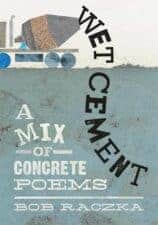
Wet Cement A Mix of Concrete Poems by Bob Raczka
Shape poems paint a picture on the page — and these do an amazing job. The Hanger poem is shaped like a hanger, Dominoes are shaped just like falling dominoes with fun texts about pushing single file down the row. I love the Corners poem about a hungry mouse looking for cheese that is shaped like a maze. These are inspiring!

Record-Breaking Natural Disasters by Mr. DeMaio, illustrated by Saxton Moore
Earthquakes, tornadoes, volcanoes, floods, and much more — which were the biggest and did the most damage? Dr. DeMaio gives you the scoop! Full-color photographs, cartoons, and fast facts, you’ll read the most important details for each natural disaster with funny commentary from Mr. DeMaio and his muppet students.

The Diamond and the Boy: The Creation of Diamonds & the Life of H. Tracy Hall by Hannah Holt, illustrated by Jay Fleck
Brilliantly conceived and exceptionally written using a parallel storytelling. The structure shows the similarities between the rocks of the earth and a boy’s life using the descriptions of HEAT, PRESSURE, CHANGE, and WAITING. As we read, we learn about the graphite in the earth as well as the curious boy who finds solace in the library. We see the diamonds waiting to be discovered while the boy grows up to work in a lab where he patiently builds an invention — a machine that makes diamonds. (This is a real thing!) I love the unique presentation and beautiful wordsmithing in this 2018 book.

What Makes a Monster? Discovering the World’s Scariest Creatures by Jess Keating, illustrations by David DeGrand
Monsters — real animal monsters — is a topic that kids love reading about. Keating writes in a way that gives kids lots of information in a readable, engaging way. I love the design, too –it’s a mix of photographs, illustrations, cool fonts, and bright colors. What Makes a Monster is a must-read filled with unexpected information about fascinating, dangerous animals.

The Toad: The Disgusting Critters Series by Elise Gravel
Visually captivating with interesting, just-right text that is informative and sometimes hilarious. I’m a fan of this kid-friendly nonfiction book series! (also read: The Worm, The Fly, and The Rat)

River Stories by Timothy Knapman, illustrated by Ashling Lindsay & Irene Montano
Unfold the multiple pages to read the history, facts, and geography of these famous world rivers — the Nile, the Mississippi, the Rhine, the Yangtze, and the Amazon. Packed with information and lovely illustrations, this will make a good addition to classrooms and homeschool libraries.

Beginners United States Atlas National Geographic Kids (2020)
A MUST-OWN BOOK! Updated for 2020, this is a gorgeous, easy-to-use oversized atlas perfect for ages 4 to 12. Each state gets a two-page spread with a large map, a small map showing full-color photographs, the state’s location in the U.S., important facts, land and water features, history about the state. Organized by region, it’s easy to find what you’re looking for. The text is simple and readable, perfect for primary grades like 1st, 2nd, and 3rd grades.

he Official DC Super Hero Joke Book by Michael Robin, Sarah Parvis, and Noah Smith
Just in time for this summer’s DC and Marvel movies, comes a joke book to keep kids laughing and reading. And if your kids are like mine, they’ll read them all aloud TO YOU. I apologize in advance. ? But reading is good — and so is groaning, chortling, and giggling! Here’s a Flash joke to give you the gist: Why does The Flash love watching science documentaries? He finds them fast-inating.

Pink is for Blobfish: Discovering the World’s Perfectly Pink Animals by Jess Keating
These aren’t your princess pink variety of pink animals. No! In fact, these are gelatinous blobfish, hairy tarantulas, naked mole rats, and more — that just happen to be pink. Great writing pairs perfectly with photographs and cartoons. I love this book!

When Green Becomes Tomatoes Poems for All Seasons by Julie Fogliano, illustrated by Julie Morstad
Beautifully written and illustrated, these poems capture the beauty of each season in relatable verses that seem like magic just like the poem below describes the first snow.
december 29
and i woke to a morning
that was quiet and white
the first snow
(just like magic) came on tip toes
overnight

The Blobfish Book by Jessica Olien
I LOVE how creative this book is with a cartoon-like blobfish with a big personality who interjects said personality during the book’s photograph and textual information about life in the deepest parts of the ocean. Perfect text to picture ratio (aka. not too much!) makes this a nonfiction home run!

Honeybee: The Busy Life of Apis Mellifera by Candace Fleming, illustrated by Eric Rohmann
Amazing, gigantic illustrations give us a bees-eye view of a honeybee’s life from her birth to the days of working in the hive, guarding the hive, and searching for nectar. Beautifully written and illustrated, this book accomplishes being an informative book about the life-cycle of bees that sensitively ends with a reflection of our honeybee’s accomplishments (“She has visited thirty thousand flowers…Her work is done.”), her final flight in the warm air, and the birth of a new honeybee.
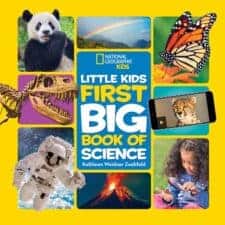
Little Kids First Big Book of Science by Kathleen Weidner Zoehfeld
Buy this book for your primary classroom or homeschool, it’s a beautiful presentation of science concepts including life science, earth and space, physical science, and inventions. Eye-pleasing, colorful photographs and layouts make this kid-friendly and readable.

So You Want to Be a Ninja? by Bruno Vincent, illustrated by Takayo Akiyama
Engaging and entertaining, full of facts, trivia, quizzes, and fun, this is the essential illustrated guide for ninjas-in-training. Three friends travel back in time to 1789 Japan where they’re taught by famous ninjas.

LOL 101: A Kid’s Guide to Writing Jokes by David Roth and Rinee Shah, illustrated by Rinee Shah
What an incredible teaching guide to writing your own jokes! This book guides readers in understanding and applying humor from wordplay, the rule of 3, exaggeration, joke delivery, visual humor, and tips for flop jokes. The examples are so helpful, too. Think about the sound a duck makes — and what word sounds like the word quack. Next, the authors explain how to write a joke where you play with the word quack to write a funny joke about a duck’s favorite snack. (answer: cheese and quackers.) I highly recommend this children’s book about making up jokes.

The Story of Walt Disney: A Biography Book for New Readers by Susan B. Katz
Clearly written, this beautifully-designed early chapter book biography gives kids a good understanding of Walt Disney’s life with illustrations, timelines, and bolded vocabulary words. Katz chooses the most important information to show readers how Disney grew an idea into a theme park and brand.

Hippos Can’t Swim and Other Fun Facts by Laura Lyn DiSiena and Hannah Eliot, illustrated by Pete Oswald
My daughter loved this book so much she read all the facts to me throughout her reading of it. It’s in a picture book format with lovely illustrations making it enticing to read. Did you know these facts . . .
. . . zebras are attracted to things that are black-and-white striped – just like they are. If you painted black-and-white stripes on a wall, a zebra would walk toward it.
. . . worker ants in a colony don’t sleep all day or all night. Instead, they each take about 250 naps throughout the day, each nap lasting just longer than a minute.
I bet your 8 year olds won’t want to put this book down, either.

You Are Home: An Ode to the National Parks by Evan Turk
Gorgeous oversized illustrated pages capture the natural beauty in our National Parks with lyrical text that invites us into the experience with all our senses. “…beneath the soaring doorways of stone and peaks that pierce the ceiling of clouds…from every river, star, and stone comes the eternal refrain: you are home.” Back matter shares more about the parks and animals in the book. This rich ode to nature is a must-read mentor text for descriptive writing.

What if You Could Spy Like a Narwhal?! by Sandra Markle, illustrated by Howard McWilliams
Narwhals use echolocation to find food and survive. If you had echolocation, you might discover a sunken treasure or find the shortest way out of a maze. Learn fascinating facts and unique characteristics (superpowers) about interesting animals a narwhal, lyrebird, giant cuttlefish, three-banded armadillo, or a colugo.

The Brain Is Kind of a Big Deal by Nick Seluk
Kids will learn so much about the brain in this well-done, humor-filled book with pacing and flow that will hold readers’ attention. Plus, they’ll love the cartoon panel illustrations and the text to picture ratio.

A Zeal of Zebras by Whoop Studios
Reading this picture book, I couldn’t help but wonder who the heck made up these crazy animal group names. You’ll see when you read this crazy (and informative) book about the collective names of species. For example . . .
an implausibility of gnus
an ostentation of peacocks
a pandemonium of parrots
a troubling of goldfish
Hard to believe, isn’t it?! But, it’s a GREAT conversation starter at dinner and fun to learn. Which will be your favorite?

The House That Cleaned Itself: The True Story of Frances Gabe’s (Mostly) Marvelous Invention by Laura Deashewitz and Susan Romberg, illustrated by Meghann Rader
An awe-inspiring biography with excellent writing and lovely pastel illustrations! Frances’s jaw-dropping inventions for cleaning her house are quite inventive. She’s a really smart problem-solver, that’s for sure. When she gets fed up with her “job” doing all the housework, she creates a house with rooms that clean themselves. Imagine an automatic carwash inside the house with air jets and a slanted floor!! Although her ideas didn’t catch on, maybe one day another inventor will build on Frances’s ideas.

Manhattan: Mapping the Story of an Island by Jennifer Thermes
I couldn’t put this down! It’s the history of the island of Manhattan starting with the Lenape people and continuing to the present day with subways and bridges and 1.6 million people. You might not know that when settlers organized into a city, the city’s long-term plans meant that homes and farms were relocated and destroyed which also happened when Central Park was later created. That’s when eminent domain forced an entire African American community called Seneca Village to move, disappearing forever. This book is packed with information about the city including the ecosystem, fires, and slavery. Gorgeous illustrations and readable informative writing, this oversized picture book will interest all readers, especially those who like American history or live in the New York area. Highly recommended.

Animal Planet Animals A Visual Encyclopedia by Animal Planet
Beautiful photographs and bite-sized chunks of information showcase more than 2,500 animals from the seven major animal groups: mammals, birds, reptiles, amphibians, insects and arachnids, invertebrates, and fish are featured in 1,050 stunning full-color photos, plus dynamic illustrations, maps, and charts.

Strange But True! Our Weird, Wild, Wonderful World DK
This is a favorite book — I literally couldn’t help but read so many of the pages out loud to my kids, they were just so interesting. First the photographs grab your attention — then the headlines — and then the text. This is a GREAT book for your reluctant readers because it’s practically irresistible to read through it. Love it for a gift idea!

Animal Planet Animal Atlas
Extra-large pages of continents show the biomes and animals who live in each. Subsequent pages feature colorful close-up photographs of animals matched with information about the animal– where it lives, why it lives there, and what it eats. This atlas is SO colorful and well designed, any reader will be drawn to look at the photographs and read it extensively. Impressive!

Copycat Science by Mike Barfield
Part biographies and part experiments, this nonfiction book narrated in cartoon format makes science fun! Learn about each scientist in their short biography, then apply and learn more about their area of study by doing the related experiment. Read about James Audubon then make a bird feeder. Then read about Rosalind Franklin and do an experiment about strawberry’s DNA. Topics include living things, human biology, materials, air, electricity and magnetism, forces and physics, astronomy, math, and more.

LEGO Awesome Ideas What Will You Build?
Awesome barely begins to describe this book — it’s jam-packed with so many ideas from different themes like Outer Space, Modern Metropolis, the Wild West, Fantasy Land, and The Real World. I just love browsing through the ideas. Be warned: Your kids will want you to order A LOT more Legos for these new projects.
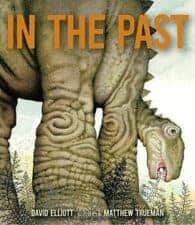
In the Past: From Trilobites to Dinosaurs to Mammoths in More Than 500 Million Years by David Elliott, illustrated by Matthew Trueman
Aptly oversized to reflect many of the gigantic creatures within, these poems and gorgeous illustrations celebrate prehistoric creatures. Creatures like the weird-looking dunkleosteus or terrifying yutyrannus. Some of these creatures you’ll know, many will be new. The text is very accessible. Each creature includes their scientific name plus the geologic timeline in which they lived. SO cool, right? “Meganeura
No birds yet.
Only you in the sky.
Meganeuropsis permiana:
the giant dragonfly!”

Snakes
This level 3 early reader book is visually appealing with solid information and good photographs like all the TFKs books and their magazine.

Six Dots: A Story of Young Louis Braille by Jen Bryant, illustrated by Boris Kulikov
Fascinating and important history meet gifted storytelling in this new picture book biography about Louis Braille. We follow the life of precocious, sightless Louis who desperately wants to read and write but is disappointed with his limited options. Despite being chronically ill, a child, and lots of failed attempts, Louis invents a system for the blind to read and write that is still in use today.

The Frog Book by Steve Jenkins and Robin Page
Densely packed with facts about frogs from the basics to finding a mate to reproduction and species, this beautifully illustrated book is the only field-guide to frogs that your kids will ever need. Holy moly will your 3rd graders will learn a lot!

Hiawatha and the Peacemaker by Robbie Robertson, illustrated by David Shannon
The Peacemaker was a real person who choose a man named Hiawatha to help him communicate his message of peace and unity to the five nations of Iroquois. The message wasn’t well-received at first but the Peacemaker helped the tribal leaders understand forgiveness and unity. United, the Iroquois nation became a model for democracy which was said to have influenced Benjamin Franklin and Thomas Jefferson.

Rocket to the Moon: Big Ideas That Changed the World by Don Brown
Instead of reading a narrative nonfiction book, this fact-filled history about the first moon landing is an exciting, well-written, black-and-white graphic novel. Reading this book will help your 8 year olds understand our country’s competitiveness with Russia, the many attempts to launch rockets, and the eventual success of sending astronauts into space.

20,000 Leagues Under the Sea: A Puzzle Adventure by Aleksandra Artymowska
We’re enjoying this search and find and spot the difference puzzle book where readers help Captain Nemo search for adventure and treasure. Each full-page spread is intricately illustrated so there is a lot to notice. Then use these illustrations to solve the tasks. For example, find a diving helmet that is different from the others. Or find identical seashells. Fun, right?

Weird But True 3 by National Geographic
Not only do 8-year-olds universally love these weird and random facts but design of the book makes readers think they’re not really reading. Why? Because there are tons of colorful photographs and just one sentence fact per page. Which is perfect to entice even the most reluctant of reader, don’t you think? And, you can pick it up in the middle and don’t have to remember what happened earlier. So it doesn’t matter about what the fact is before you read that rat’s can’t burp and birds don’t sweat. Who cares?! All you know is that rats probably have serious gastro issues.

Weird But True SPORTS: 300 Wacky Facts About Awesome Athletics National Geographic Kids
I wasn’t sure what to expect but again, National Geographic outdid themselves. The facts weird (did you know professional hockey players can be penalized for tucking their jerseys into their pants?!) and come from a wide range of topics and sports. Learn crazy facts about skateboarding, ostrich races, and jetsprint boats! Highly recommended. ALSO READ: Awesome Sports Books for Kids

Almanac 2025 National Geographic Kids
The National Geographic Almanac is a must-own resource for families. Practice your nonfiction reading comprehension skills as you learn about animals, space, science, history, geography, and much more. Each page is designed to entertain and educate with stunning layouts and eye-popping photographs.

Mad Libs Junior Animals
Make up super silly stories with your friends and family. No need to remember parts of speech because the junior book uses pictures instead. Best for kids in first, second, and third grades, or ages 6 – 9.

Sticker Dolly Dressing on Vacation by Lucy Bowman, Vici Leyhane, Stella Baggott
24 pages and stickers of girls on vacation — my own kids adore these sticker books and save them forever. (Much to my dismay.)

A-Maze-Ing Animals 50 Mazes for Kids by Joe Wos
I saw this book on a tweet and fell in love with it! Each of the mazes is a design of the animals in 5 difficulty levels. From bats hanging in a cave to colorful underwater creatures, these mazes will develop visual-spatial skills in a totally fun, engaging way. And I’m pretty positive that once you get started, you won’t want to stop.

Gecko by Raymond Huber, illustrated by Brian Lovelock
Set up in a parallel structure, we read the narrative story about a day in the life of Gecko as well as expository facts about geckos. Visually appealing and interesting.

Elephants on Tour: A Search & Find Journey Around the World by Guillaume Cornet
I really like the integration of geography and world cultures in this fun search and find book! And maybe, it makes me a little nostalgic for Barbar. 🙂 Because elephants. Five elephants are traveling the world — find them on each page. The illustrations are minuscule and enchanting! Each location’s two-page spread shows where the elephants are visiting next from the Amazon to Madagascar and Amsterdam. You’ll also see a “Fact File” with the country, currency, language, and population. Another fact overlay shares how to say hello, places to visit, things to do, what to buy, and what to eat. Cool, right?!

If an Egg Hatches . . . and Other Animal Predictions by Blake A. Hoena
I like this book for two reasons. First, the fantastic color photographs. Second, the questions that get the reader to engage fully with the text before they flip the page to read the answer. For example: “Every animal in nature is important. Imagine if there weren’t any predators like wolves. What would happen to the populations of elk and deer?”

Show Me Dogs My First Picture Encyclopedia by Megan Cooley Peterson
Do your kids love animals? This book, and others like it in this well-designed series will entice your kids to devour facts all about the animal they love — like dogs!

Sir Cumference and the Roundabout Battle A Math Adventure by Cindy Neuschwander, illustrated by Wayne Geehan
Sir Cumference’s son, Round 2, counts and adds everything. Round 2 counts, rounds, and adds. Sometimes he counts the weapons, sometimes soldiers. Sometimes he uses a number line aka. a measuring tape. Round 2 uses rounding to ten in order to make addition easier. Doing so helps his father win the battle against Sir Wantsalot. This is a fun addition (get it?!) to the Sir Cumference picture book series.

Austin, Lost in America A Geography Adventure by Jef Czekaj
A lonely pet store dog escapes to search for a forever family. He travels the United States, searching and learning more about each state. Surprisingly, despite the large number of states and information presented, the author makes this nonfiction adventure for kids entertaining.

Highlights Hidden Pictures Sticker Book
Younger learners can the stickers to find the hidden objects. So fun! My kids always preferred the sticker hidden picture books to the color books.

Where Did My Clothes Come From? by Chris Butterworth, illustrated by Lucia Gaggiotti
Learn about cotton and how it goes from the field to machines, to spinners, and then to clothes. Read about yarn how it starts from sheep and then as it becomes a sweater. Overall, I found this picture book fascinating — filled with so much information!

Tree of Wonder: The Many Marvelous Lives of a Rainforest Tree by Kate Messner, illustrated by Simona Mulazzani
Warm illustrations meet beautiful writing in this new nonfiction picture book about the warm-wet rainforest. Count along as you learn about rainforest animals and plants. Count 6 roaring howler monkeys, 62 agoutis, or 512 Rusty Wandering Spiders. It’s a beautiful book with the perfect amount of text (not too much).
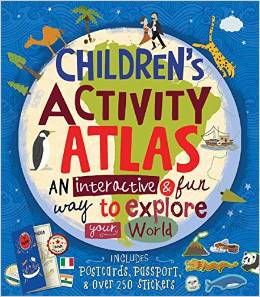
Children’s Activity Atlas
Colorful illustrated maps with flags, animal, and landmark stickers, postcards, and a passport book make this a great interactive for geography enthusiasts. (I’ll admit, I wanted to steal it from my children and do the stickers myself.)

Orangutan Houdini by Laurel Neme illustrated by Kathie Kelleher
What an interesting picture book story based on real-life story! Fu Manchu, the orangutan, keeps escaping from his enclosure in the zoo. He doesn’t leave the zoo, just hangs out in the trees, and always returns when his keeper comes to get him. Fu is one clever orangutan! Written like a story in a narrative format, this is an excellent nonfiction picture book.

Tuesday Tucks Me In: The Loyal Bond between a Soldier and his Service Dog by Former Captain Luis Carlos Montalvan, USA with Bret Witter, photographs by Dan Dion
This picture book follows a typical day in the life of Luis and Tuesday from breakfast to bedtime. The photographs are gorgeous! It’s powerful to witness the bond between a service dog, Tuesday and his person, Luis who experiences post-traumatic stress disorder and other disabilities. Tuesday helps Luis with his nightmares and helps him balance as he walks down the subway stairs.

Tiger by Suzi Eszterhas
Read about tiger cubs as they grow up in India. See the tigers in their rocky cliff cave, learn that the cubs won’t grow into all their stripes for two years, watch the family move to a new forest den, follow as the cubs learn to hunt, and then see how big the tigers get in two short years. A page of tiger facts finishes out this book.

Glow Animals with Their Own Night-Lights by W.H. Beck
I LOVE the photography in this beautiful nonfiction picture book and think you will as well. Brightly colored (glowing) plants and animals with bioluminescence pop out of the pages on black backgrounds. Each two page spread page has both large and medium sized text with the perfect amount of text — not too much! Read to find out why these creatures glow. You’ll learn how they use this adaptation for a purpose such as hunting, hiding, and tricking. Impressive.

DNA Detective by Tanya Lloyd Kyi, illustrated by Lil Grump
Colorful and easy to read, I very much enjoyed this informational book and it’s kid-friendly layout. Plus it’s packed full of fascinating facts about the science of DNA and how researchers figured it out and use it in practical applications like solving crimes.

Tree Lady: The True Story of How One Tree-Loving Woman Changed a City Forever by H. Joseph Hopkins, illustrated by Jill McElmurry
Kate Sessions helped plant San Diego with a variety of trees that would grow in the city’s climate. She worked hard to make sure that by the World’s Fair, there were enough trees for shade that the attendees wouldn’t be too hot. Beautifully written and illustrated!

A Strange Place to Call Home: The World’s Most Dangerous Habitats & the Animals That Call them Home by Marilyn Singer, illustrated by Ed Young
You got to love a poetry book about ice worms, spadefoot toads, limpets, and other animals who live in dangerous habitats. Here’s an example:
Well-Oiled
petroleum flies
Thousands
of them are born
in carrion, water,
or soil. But not this crew. They hatch
in oil.
The mixed media collage illustrations will blow you away. Fabulous.

Snakeopedia (Discovery Channel)
Gorgeous photos that gross me out and enchant snake lovers fill Snakeopedia. While I might say yuck, this is a terrific snake book filled with amazing photography and fascinating facts about the 12 snake families, the features of different snakes, which are dangerous, and other snaky stuff. I highly recommend this book. If you’re not afraid like me. 🙂

Smithsonian Sticker Creations Wildlife by Kaitlyn DiPerna
I really like this interactive book with it’s eye-catching photographs, perfect text to picture ratio, and stickers. 8-year-old readers will learn about specific animals, animal groups, and more.
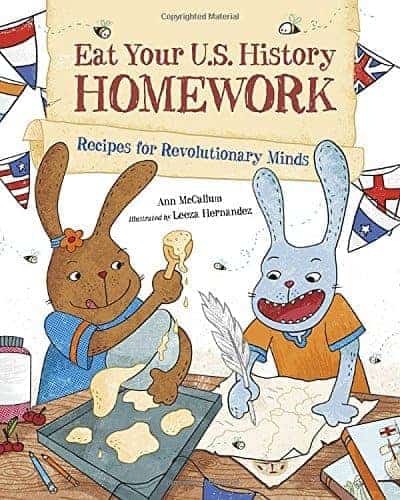
Eat Your U.S. History Recipes for Revolutionary Minds by Ann McCallum, illustrated by Leeza Hernandez
History-themed recipe book with recipes for Thanksgiving Succotash, Revolutionary Honey-Jumble Cookies, and Independence Ice Cream, among other foods, will give kids background and information about each and a yummy way to discover early American history.

The Ultimate Pirate Handbook: Everything you need to know about pirate life by Libby Hamilton, Mathieu Leyssenne, and Jason Kraft
This pirate book has it all — pop-ups, lift-the-flaps, and cartoon-like illustrations with fascinating tips and facts about pirate life. You’ll love the humor in this book, too — like the pirate personal hygiene section. This is the nitty-gritty (literally) of pirate life, right? I particularly like the Pirate sickness page — this is good stuff, my friends!

Guide to Photography National Geographic Kids by Nancy Honovich and Annie Griffiths
Learn the equipment, the best composition, and so many tips for cool photographs on your digital cameras or smartphones. We like that you can flip through and find ideas quickly, that it’s not a cover to cover read.

Around the World in 80 Puzzles by Aleksandra Artymowska
This is a GREAT gift book for the entire family to enjoy. Visual discrimination never looked so beautiful! My kids and husband were hooked on it as soon as this book arrived in the mail. So together or individually, you’ll have so much fun with this book that celebrates the world! I love how the puzzles give kids practice with visual discrimination skills and following directions. And in this unique book, there is a lot of white space while still requiring detail orientation. See the pieces of the Eiffel Tower and answer — “Which of these pieces isn’t part of the Eiffel Tower?” and “Can you arrange the other pieces in the correct order?“

I, Fly The Buzz About Flies and How Awesome They Are by Bridget Heos, illustrated by Jennifer Plecas
8-year-olds will enjoy this picture book with comic dialogue about the oft-neglected fly. You see, kids always study butterflies and rarely know that flies metamorphose, too — and Fly wants to convince you that you should really know more about him! Flies are so interesting — they make noise (butterflies don’t) and they have big families (500 maggots) and help solve crimes (age of maggots on a dead body . . . ) just to name a few things.

Feathers: Not Just for Flying by Melissa Stewart, illustrated by Sarah S. Brannen
I think this nonfiction picture book actually has the perfect ratio of words to text! It’s informative without being an epic essay and the warm water-color illustrations are gorgeous. You’ll learn that feathers can shade, warm, protect like sunscreen, make high-pitched sounds. You’ll discover examples of birds in the wild with each feather fact. Honestly, I never appreciated feathers before this book. It’s so well-presented, it should be included in all classroom studies on birds.

Winnie The True Story of the Bear Who Inspired Winnie-the-Pooh by Sally M. Walker, illustrated by Jonathan D. Voss
Did you know that Winnie the bear was a real bear? Canadian vet and WWI soldier, Harry Colebourn, rescued a bear who he named Winnipeg and took her with him to training in England. But when he was sent to battle, Harry sent her to the London Zoo so she would be safe from battle. That’s where Christopher Robin and his father, A. A. Milne, met Winnie. The real Winnie are so cool!
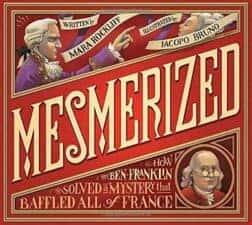
Mesmerized: How Ben Franklin Solved a Mystery that Baffled All of France by Mara Rockliff, illustrated by Iacopo Bruno
A little known piece of Ben Franklin history, we see him use the scientific method to figure out what Dr. Mesmer was really doing. Was it magic, science, or was Dr. Mesmer a fraud? Excellent images, design, and compelling plot!

The Scary Places Map Book Seven Terrifying Tours by B.G. Hennessy, illustrated by Erwin Madrid
Kids will read, think, view, and do in this super-cool book of maps. The seven terrifying tours include Captain Davy Jones’ Ghostly Galleon, Land of Mythical Monsters, Transylvania, Nightmare House, and more. Each tour includes background about the horrifying horrors, the dangers, a map on a grid, and directions. For example, in the Western Terror-tories, the directions start, “Hop off the stagecoach in Tombstone J1. Gruesome Gus will meet you at the Depot. Before you head out, Gust will take you on a tour of Bone Orchard. I1.” The back of the book contains more details to spot.

KEEP READING
Nonfiction Book Lists for All Ages
Short, Nonfiction Books for Reluctant, Struggling, and Wiggly Readers



